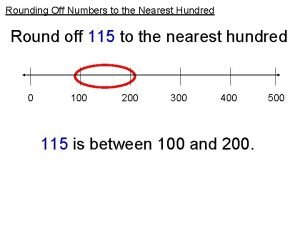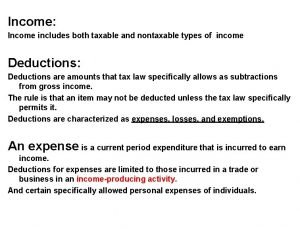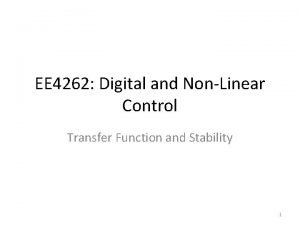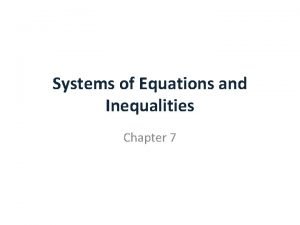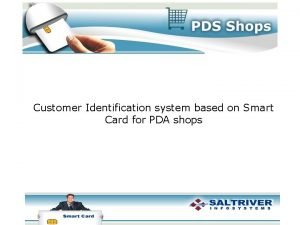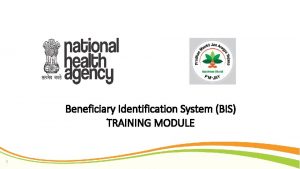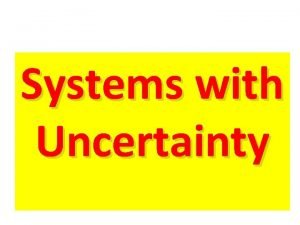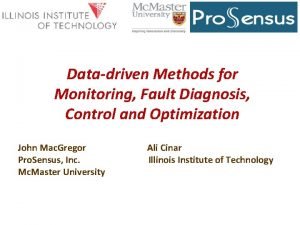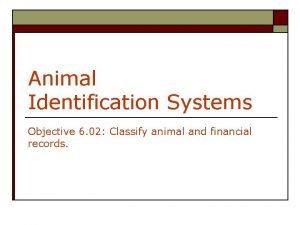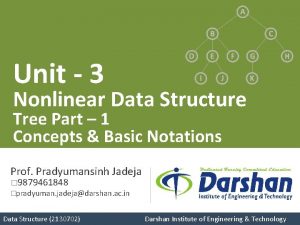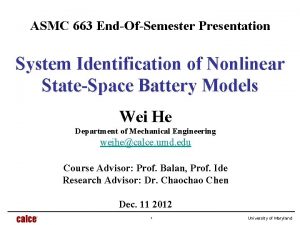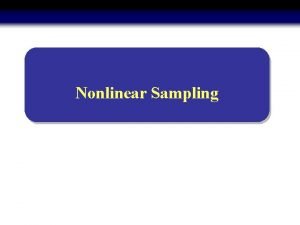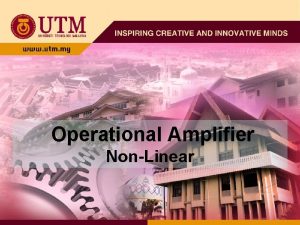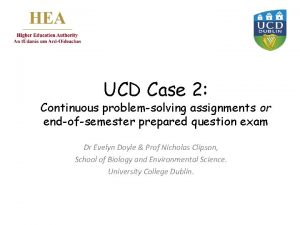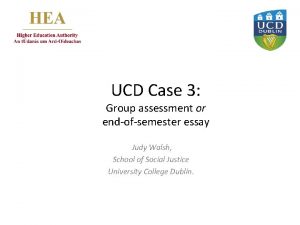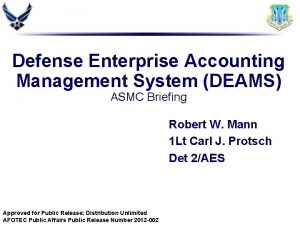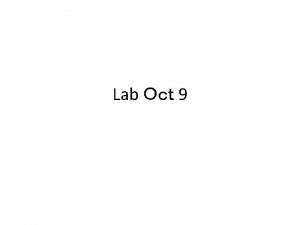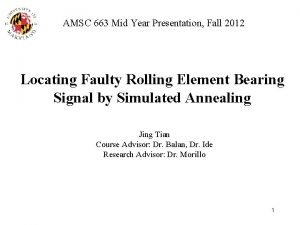ASMC 663 EndOfSemester Presentation System Identification of Nonlinear


![State-Space Representation of A Battery System • Process function [1 -3] : • Measurement State-Space Representation of A Battery System • Process function [1 -3] : • Measurement](https://slidetodoc.com/presentation_image_h2/d50ed0a1efaf31ebdca45c61fb7997e3/image-3.jpg)


![Expectation Maximization (EM) • Ref[4] have proved that by a particle smoother: can be Expectation Maximization (EM) • Ref[4] have proved that by a particle smoother: can be](https://slidetodoc.com/presentation_image_h2/d50ed0a1efaf31ebdca45c61fb7997e3/image-6.jpg)



![Particle Filtering [5] P(x) x tk+1 t actual state value actual state trajectory measured Particle Filtering [5] P(x) x tk+1 t actual state value actual state trajectory measured](https://slidetodoc.com/presentation_image_h2/d50ed0a1efaf31ebdca45c61fb7997e3/image-10.jpg)

![Particle Filter Algorithm [4 -7] 1. Initialize particles, 2. Predict the particles by drawing Particle Filter Algorithm [4 -7] 1. Initialize particles, 2. Predict the particles by drawing](https://slidetodoc.com/presentation_image_h2/d50ed0a1efaf31ebdca45c61fb7997e3/image-12.jpg)
![Particle Smoother Algorithm [4 -7] 1. Run the particle filter and store the predicted Particle Smoother Algorithm [4 -7] 1. Run the particle filter and store the predicted](https://slidetodoc.com/presentation_image_h2/d50ed0a1efaf31ebdca45c61fb7997e3/image-13.jpg)






- Slides: 19

ASMC 663 End-Of-Semester Presentation System Identification of Nonlinear State-Space Battery Models Wei He Department of Mechanical Engineering weihe@calce. umd. edu Course Advisor: Prof. Balan, Prof. Ide Research Advisor: Dr. Chaochao Chen Dec. 11 2012 1 University of Maryland

Background • Lithium-ion batteries are power sources for electric vehicles (EVs). • State of charge (SOC) estimation of batteries is important for the optimal energy control and residual range prediction of EVs. • SOC is the ratio between the remaining charge (Qremain) and the maximum capacity of a battery (Qmax) Full: SOC = 100% Empty: SOC=0% 2 University of Maryland
![StateSpace Representation of A Battery System Process function 1 3 Measurement State-Space Representation of A Battery System • Process function [1 -3] : • Measurement](https://slidetodoc.com/presentation_image_h2/d50ed0a1efaf31ebdca45c61fb7997e3/image-3.jpg)
State-Space Representation of A Battery System • Process function [1 -3] : • Measurement function: Problem Statement • Process and measurement noise 3 The model parameters need to be identified University of Maryland

Problem Formulation • Estimate the unknown parameters in based on the information in the measured input-output responses using a maximum likelihood framework 4 University of Maryland

Expectation Maximization (EM) • Expectation step (E step): calculate the expected value of the log likelihood function, with respect to the conditional distribution of XN given YN under the current estimate of the parameters [4] where X is the state variables: SOC and Vp. • Maximization step (M step): find the parameter that maximizes this quantity: If not converged, update k->k+1 and return to step 2 5 University of Maryland
![Expectation Maximization EM Ref4 have proved that by a particle smoother can be Expectation Maximization (EM) • Ref[4] have proved that by a particle smoother: can be](https://slidetodoc.com/presentation_image_h2/d50ed0a1efaf31ebdca45c61fb7997e3/image-6.jpg)
Expectation Maximization (EM) • Ref[4] have proved that by a particle smoother: can be approximated 6 University of Maryland

Particle Filter and Smoother • Particle smoother: – The particle smoother weights can be recursively calculated from particle filter weights • Particle filter: 7 University of Maryland

Particle Filtering • Model prediction given past measurements Process function 8 University of Maryland

Particle Filtering • Prediction update using current measurement posterior Measurement Equation 9 State Prediction University of Maryland
![Particle Filtering 5 Px x tk1 t actual state value actual state trajectory measured Particle Filtering [5] P(x) x tk+1 t actual state value actual state trajectory measured](https://slidetodoc.com/presentation_image_h2/d50ed0a1efaf31ebdca45c61fb7997e3/image-10.jpg)
Particle Filtering [5] P(x) x tk+1 t actual state value actual state trajectory measured state value estimated state trajectory state particle value particle propagation state pdf (belief) particle weight 10 • represent state as a pdf • sample the state pdf as a set of particles and associated weights • propagate particle values according to model • update weights based on measurement University of Maryland

Particle Filtering l Prediction step: use the state update model l Update step: with measurement, update the prior using Bayes’ rule: 11 University of Maryland
![Particle Filter Algorithm 4 7 1 Initialize particles 2 Predict the particles by drawing Particle Filter Algorithm [4 -7] 1. Initialize particles, 2. Predict the particles by drawing](https://slidetodoc.com/presentation_image_h2/d50ed0a1efaf31ebdca45c61fb7997e3/image-12.jpg)
Particle Filter Algorithm [4 -7] 1. Initialize particles, 2. Predict the particles by drawing M i. i. d samples according to 3. Compute the importance weights 4. For each j = 1, …, M draw a new particle according to 5. If t < N increment and set t = 1. with replacement (resample) and return to step 2, otherwise terminate. 12 University of Maryland
![Particle Smoother Algorithm 4 7 1 Run the particle filter and store the predicted Particle Smoother Algorithm [4 -7] 1. Run the particle filter and store the predicted](https://slidetodoc.com/presentation_image_h2/d50ed0a1efaf31ebdca45c61fb7997e3/image-13.jpg)
Particle Smoother Algorithm [4 -7] 1. Run the particle filter and store the predicted particles weights , for t = 1, …, N. 2. Initialize the smoothed weights to be the terminal filtered weights time t = N. and their at and set t = N-1. 3. Compute the smoothed weights and particles via 4. Update using the filtered weights . If t > 0 return to step 3, otherwise terminate. 13 University of Maryland

Simulated Data Sets • Parameter settings: • Process function: • Measurement function: • Process and measurement noise 14 University of Maryland

Simulated Hidden States 15 University of Maryland

Particle Filtering Result • Initial guess: • Particle number: 50 • RMS error = 0. 0023 16 University of Maryland

Particle Smoothing Result RMS error = 0. 0017 17 University of Maryland

Project Schedule and Milestones • Project proposal: October 5 2012 • Algorithm Implementation: - Particle filter and smoother: December 1 2012 - The full algorithm (particle EM): February 1 2012 • Validation: March 15 2012 • Testing: April 15 2012 • Final Report: May 1 2012 18 University of Maryland

References 1. 2. 3. 4. 5. 6. 7. H. He, R. Xiong, and H. Guo, Online estimation of model parameters and state-of -charge of Li. Fe. PO 4 batteries in electric vehicles. Applied Energy, 2012. 89(1): p. 413 -420. C. Hu, B. D. Youn, and J. Chung, A Multiscale Framework with Extended Kalman Filter for Lithium-Ion Battery SOC and Capacity Estimation. Applied Energy, 2012. 92: p. 694 -704. H. W. He, R. Xiong, and J. X. Fan, Evaluation of Lithium-Ion Battery Equivalent Circuit Models for State of Charge Estimation by an Experimental Approach. Energies, 2011. 4(4): p. 582 -598. T. B. Schön, A. Wills, and B. Ninness, System identification of nonlinear statespace models. Automatica, 2011. 47(1): p. 39 -49. Bhaskar Saha, Introduction to Particle Filters, NASA. M. S. Arulampalam, S. Maskell, N. Gordon, and T. Clapp, A tutorial on particle filters for online nonlinear/non-Gaussian Bayesian tracking. Signal Processing, IEEE Transactions on, 2002. 50(2): p. 174 -188. A. Doucet and A. M. Johansen, A tutorial on particle filtering and smoothing: fifteen years later. Handbook of Nonlinear Filtering, 2009: p. 656 -704. 19 University of Maryland
 650 to the nearest 10
650 to the nearest 10 888-663-8081
888-663-8081 8006631463
8006631463 Positive identification
Positive identification Nonlinear transfer function
Nonlinear transfer function Chapter 7 systems of equations and inequalities
Chapter 7 systems of equations and inequalities Non linear pipeline
Non linear pipeline Occipital brow presentation
Occipital brow presentation Vertex presentation
Vertex presentation Customer identification system
Customer identification system Beneficiary module
Beneficiary module Transportation worker identification credential
Transportation worker identification credential System identification
System identification Aerodynamics system identification key
Aerodynamics system identification key System identification
System identification System identification
System identification Potential development projects can be identified by
Potential development projects can be identified by Animal id systems - assessment v
Animal id systems - assessment v Linear and nonlinear data structure
Linear and nonlinear data structure Linear and nonlinear editing
Linear and nonlinear editing
